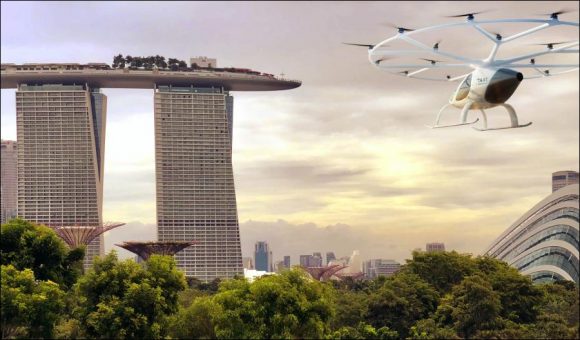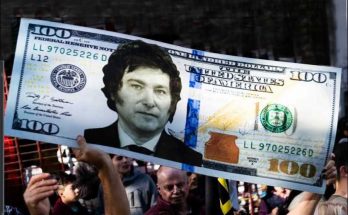Volocopter’s flying air taxi made a brief flight over Singapore’s Marina Bay on Tuesday (Oct 22). Its first flights here are made with a pilot on board – the firm’s CEO acknowledged it’s “too much to ask” from regulators and the public to accept unmanned aircraft straightaway.
While there are concerns about the safety and viability of air taxis as a mode of transport, Volocopter says it is doing everything it can to continue its 100 per cent safety rate.
“We are absolutely aware that any kind of accident will be a drawback to our efforts of introducing a new mode of transportation,” Volocopter chief executive Florian Reuter told reporters in Singapore on Monday (Oct 21).
“So we go about every step, very, very determined and careful about it.” The German firm has been flying its aircraft since 2011 without issue, he noted. “And hopefully my team is putting everything in so that they can continue the 100 per cent safety rate going forward.”
He added the unique design of the Volocopter, which has 18 rotors, reduces the chance of failure, noting that it is developed to the standards of the European Aviation Safety Agency.
Mr Reuter was speaking at the unveiling of a mock-up of a take-off and landing site for its aircraft on Monday at the Marina Bay Floating Platform.
Dubbed the Voloport, the site – developed together with British firm Skyports – made its debut in conjunction with the 26th Intelligent Transport Systems World Congress.
The German firm – which first announced last year that it would be testing its air taxis here – will be having a public flight of its air taxi in the Marina Bay area at noon on Tuesday.
Some of Volocopter’s vehicles are able to operate autonomously and the company conducted an unmanned test flight of an air taxi in Dubai in 2017.
It will initially conduct its tests here with pilots aboard as it was “too much to ask” from the regulators and the public to accept unmanned aircraft straightaway, said Mr Reuter.
While there have been concerns about the safety of self-driving cars – last year a 49-year-old woman was killed after getting hit by one of Uber’s self-driving cars in the United States – Mr Reuter said it was “much easier to automate in the air than it is on the ground”.
“We have to keep in mind that commercial airlines have been flying on autopilot for quite some time,” he added.
While its air taxis will initially integrate into existing air traffic management systems, Volocopter is working with regulators to explore what the next generation of air traffic management systems will look like, he said.
Singapore serves as a “role model” for other cities, and the firm chose the country for its “extremely professional environment”, which Mr Reuter said will help when developing an ecosystem for a new mode of transport.
Mode of transport for the masses
Volocopter sees its air taxis as a mode of transport for the masses and not an alternative to helicopters for the wealthy, the chief executive stressed.
He added that such modes of transport will eventually be “no more expensive” than taking a taxi or limousine. “We’re talking, even in the early days, hundreds of dollars – not thousands of dollars,” he said.
When asked about the sustainability of Volocopter’s business model – ride-hailing giant Uber reportedly lost more than US$5 billion in the second quarter of this year – Mr Reuter said he believes the company will be profitable.
He expects less competition as there are higher barriers to entry for air taxis than there are for ride-hailing, he said, noting it takes “a lot of money and competence” to gain the necessary certifications.
While Volocopter intends to expand into various cities internationally, this roll-out will be done gradually. We look to scale (our business), but we want to scale profitably,” he said.
Aviation consultant Priveen Raj Naidu said air taxis will complement Singapore’s transport options, adding that they could provide commuters with added convenience. “The region has an excellent environment to test and verify the need for air taxis,” he said.
Singapore University of Social Sciences transport economist Walter Theseira believes there will be little take-up of such service here. It is unlikely that many people would want to pay hundreds of dollars just to save a few minutes of travelling time, he said.
“It’s very hard to imagine that the price would be very competitive with taxi services, without some sort of major technological breakthrough,” he added.
Visits: 109



